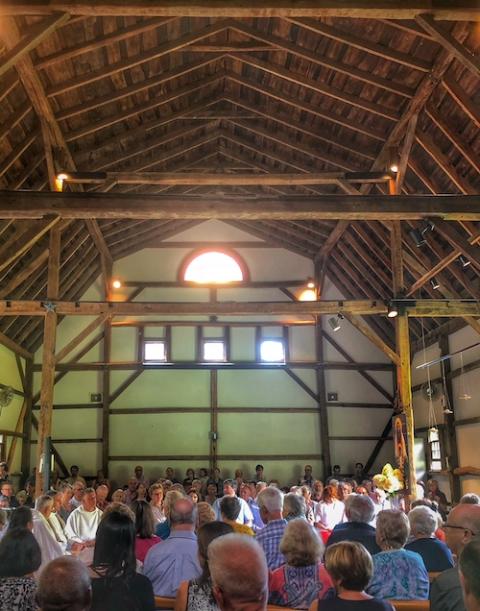For over 40 years, Sunday liturgies at the Grange drew some 200 steady visitors from Connecticut, New York and afar. Fr. John Giuliani in September 2003 (Jane McCaffrey)
Fr. John Battista Giuliani has gone back to the earth.
Giuliani, a priest of the Diocese of Bridgeport, Connecticut, for 61 years, was remembered — as an iconographer, artist, liturgist, activist, teacher, campus chaplain, a cosmic wonderer and an encourager of vocations — at a ceremony of remembrance and gratitude just weeks after his January death in Connecticut at age 88.
In attendance, not mourners in black, but scores of friends on Zoom in their supper clothes, many who had known the priest for decades and who gathered in their living rooms, studies and kitchens to recall his elegance, simplicity and beauty and his legacy of love for each of them.
They shared tales of life-changing returns to the church, of his officiating at their weddings and the baptisms of their children and grandchildren, and his extending the gift of Benedictine hospitality to each of them.
Though Giuliani was not a Benedictine, many in the audience came to know him after he established the Benedictine Grange in West Redding, Connecticut, in 1977. Intending the Grange as a monastic hermitage, Giuliani soon found himself the last man on campus until the laity discovered the rural retreat and spirituality center, some 10 miles from Danbury. For over 40 years, Sunday liturgies at the Grange drew some 200 steady visitors from Connecticut, New York and afar. Attendees added their talent and treasure to aid projects in Appalachia, Nicaragua and the Caribbean over the decades.
Some men recalled helping to raise a pre-Civil War-era barn, moved from Newtown to West Redding. With its high beams, plank floors and theater-in-the-round interior, the barn became a sacred space for liturgies vibrant with music, Scripture, prayer, homilies and candlelight. It was "a place to connect with God and each other," noted one woman.
"John, you've given birth to a family, a church, a community — something so big, even though you didn't think you had managed to meet your dream," said Notre Dame Sr. Kathleen Deignan, gazing upon the many tribute-givers at the Zoom assembly.
Deignan collaborated with Giuliani some 50 years after meeting him in 1968 when she was a student at Sacred Heart University in Fairfield, Connecticut, where he was a chaplain and teacher. When he inquired why she had chosen religious life, she told him that the Congregation of Notre Dame was a singing order and besides, "I want to be a saint."
"So do I," he told her.
Advertisement
Over four decades, she composed sacred songs for Schola Ministries and premiered them at the Benedictine Grange. The two would-be saints and artists also shared a love of nature, of spirituality and of Thomas Merton, the Trappist monk who wrote some 60 books on contemplation, war, peace, social and racial justice. It was Merton's autobiography, The Seven Storey Mountain, that drew Giuliani away from the Pratt Institute of Art in Brooklyn and into the seminary in 1952.
Some recalled how the priest had introduced them to Merton, others noted how their call to film-making, spiritual direction, religious life and spirituality began with him.
Invited by a Yale Divinity School student to offer Mass at a weekend yoga retreat of students, Giuliani "asked for a table and a tablecloth. Then he performed the consecration. He touched hearts that day," said the former Yale Divinity student, recalling that three of the students "entered into the spiritual life that day" and 47 years later are still engaged in it.
In the wake of Giuliani's retirement and the global pandemic that followed it two years later, members of the Grange still meet weekly as a diaspora community whose liturgies and preaching are carried on by Fr. John Anderson, who grew up at the Grange. Deignan called the continuity of the diaspora body "a living miracle."
Beyond his ministry at the Grange, Giuliani was best known for his art, which he returned to 37 years after leaving Pratt. As a priest and the son of Italian immigrants, he wrote that he bore "the religious and ethnic burden of ancestral crimes perpetrated on the first inhabitants of the Americas." The priest reached this conclusion close to the time the United States marked the 500th anniversary of Columbus' voyage to the Americas and his "discovery" of its Native peoples.

People gather in the barn at the Benedictine Grange in West Redding, Connecticut, September 2017. (Anne Reeves)
Giuliani drove to the Southwest, visiting Indians centuries and finding for himself their dire poverty and the loss of their culture. While many had converted to Christianity, in doing so they had found it difficult to retain their Indigenous culture, the priest wrote.
As an artist — one trained by a professional iconographer — the priest chose to depict Christian saints as Native Americans both to honor them and to acknowledge their original spiritual presence on this land. Back in his studio at the Grange, Giuliani turned out more than 20 paintings in a year — a Hopi Madonna, Lakota archangels, Jesus as a victorious Sioux warrior, a Crow Christ ascending to heaven, a Navajo Jesus breaking bread and a Cheyenne virgin and child. His depiction of Moses, Elijah and Jesus at the transfiguration reveals the manifestation of God's sacred power in traditional indigenous iconography.
"It is this lost culture, especially, that I attempt to celebrate in rendering the beauty and excellence of their craft as well as the dignity of their persons," Giuliani wrote.
Thousands of viewers have seen his works at exhibitions in museums in Connecticut, Ohio and Arizona, on display at university galleries and in churches across America, including St. John the Divine Cathedral and St. Peter's Lutheran Church, both in New York, as well as in the Basilica of St. Mary in Minneapolis and at Indian reservations in South Dakota and elsewhere. In 2010, Giuliani presented Pope Benedict XVI with a rolled portrait, painted on linen, of Blessed Kateri Tekakwitha, the Lily of the Mohawks, whom Benedict canonized in 2012.
Giuliani was fond of naming the ways in which Christians are called to incarnate Christ in their lives, to clothe their lives with him so that people can see him, touch him and recognize him in each other. Using his artist's tools and his priestly ministry, the priest-artist appeared to many to have become an icon of the Christ he so loved.








